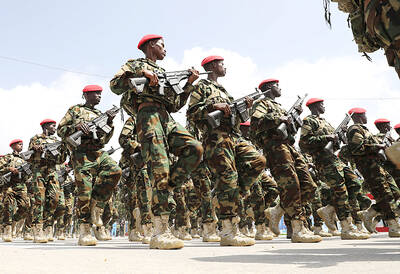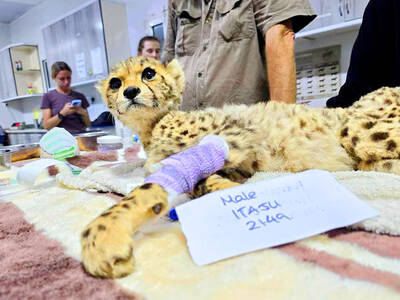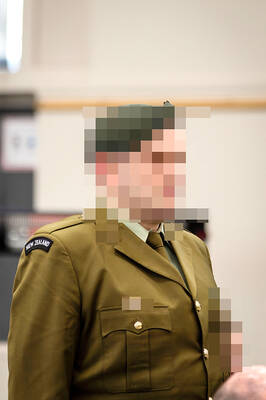The moment when the 11-year-old Liverpool schoolboy Rhys Jones was shot as he crossed a pub car park on his way home from soccer practice, filmed by a closed circuit television (CCTV) camera, was shown to a jury at the city’s crown court on Thursday at the start of the trial of an 18-year-old youth accused of his murder.
Sean Mercer, allegedly a member of the Croxteth Crew gang, denies murdering Rhys, who the court heard was shot in the back with a Smith and Wesson revolver.
Rhys’s father, Stephen Jones, looked strained and clutched a handkerchief as the indistinct and jerky footage from surveillance cameras was shown. A few moments earlier his wife Melanie, who had cradled their son in her arms as he died, left the court in tears as the prosecution began to describe his final moments.
Rhys’s shooting in August last year, in front of early evening drinkers sitting outside on a sunny evening, caused national outrage and prompted extensive media coverage of one of the youngest victims of apparent teenage gang rivalries.
The prosecutor, Neil Flewitt, told the jury that Rhys, on his way home from football practice on Aug. 22, had ended up “walking into the line of fire” in a war between the Croxteth Crew and rivals from neighboring Norris Green, known as the Strand Gang or Nogga Dogs.
The film extracts, taken from several cameras around the Fir Tree pub on a residential estate, an area once used as the model for the television soap opera Brookside, showed a youth, dressed in black, ride up on a mountain bike and allegedly fire three shots across the car park at members of the rival gang.
One shot could be seen hitting the window of a parked car; another sent up dust from an ornamental wishing well. Rhys could be seen starting to cross the car park, then turning as if in reaction to the first explosion and falling to the ground. After the shots, the black-clad youth could be seen cycling away at speed.
Flewitt said: “The overwhelming impression gained by the witnesses was that the gunman was a pale young man dressed mainly in black. He was wearing a hooded top and riding a predominantly black mountain bike. The witnesses describe the gunman standing astride his bicycle with both hands stretched out in front of him as if aiming his gun across the car park.”
He told the court Rhys was already in cardiac arrest before an ambulance crew arrived. He was hit once behind the left shoulder as he turned. The bullet exited through the front of his neck.
In the dock, behind glass screens and separated by prison staff, the defendants watched the footage impassively, with Mercer, dressed in a black shirt, occasionally slightly shaking his head.
The jury was told Mercer was originally arrested three days after the shooting and that aspects of his story of cycling in search of his friends were borne out by other CCTV cameras, but a mother of one of the juveniles had said he had left her house while the soap opera Emmerdale was still showing — the program ended a few minutes after the shooting took place.
The prosecution case will include evidence of conversations between defendants and their parents, derived from police bugging of their homes. Mobile phone records were said also to indicate collusion between defendants.

ELECTION DISTRACTION? When attention shifted away from the fight against the militants to politics, losses and setbacks in the battlefield increased, an analyst said Recent clashes in Somalia’s semi-autonomous Jubaland region are alarming experts, exposing cracks in the country’s federal system and creating an opening for militant group al-Shabaab to gain ground. Following years of conflict, Somalia is a loose federation of five semi-autonomous member states — Puntland, Jubaland, Galmudug, Hirshabelle and South West — that maintain often fractious relations with the central government in the capital, Mogadishu. However, ahead of elections next year, Somalia has sought to assert control over its member states, which security analysts said has created gaps for al-Shabaab infiltration. Last week, two Somalian soldiers were killed in clashes between pro-government forces and

Ten cheetah cubs held in captivity since birth and destined for international wildlife trade markets have been rescued in Somaliland, a breakaway region of Somalia. They were all in stable condition despite all of them having been undernourished and limping due to being tied in captivity for months, said Laurie Marker, founder of the Cheetah Conservation Fund, which is caring for the cubs. One eight-month-old cub was unable to walk after been tied up for six months, while a five-month-old was “very malnourished [a bag of bones], with sores all over her body and full of botfly maggots which are under the

BRUSHED OFF: An ambassador to Australia previously said that Beijing does not see a reason to apologize for its naval exercises and military maneuvers in international areas China set off alarm bells in New Zealand when it dispatched powerful warships on unprecedented missions in the South Pacific without explanation, military documents showed. Beijing has spent years expanding its reach in the southern Pacific Ocean, courting island nations with new hospitals, freshly paved roads and generous offers of climate aid. However, these diplomatic efforts have increasingly been accompanied by more overt displays of military power. Three Chinese warships sailed the Tasman Sea between Australia and New Zealand in February, the first time such a task group had been sighted in those waters. “We have never seen vessels with this capability

‘NO INTEGRITY’: The chief judge expressed concern over how the sentence would be perceived given that military detention is believed to be easier than civilian prison A military court yesterday sentenced a New Zealand soldier to two years’ detention for attempting to spy for a foreign power. The soldier, whose name has been suppressed, admitted to attempted espionage, accessing a computer system for a dishonest purpose and knowingly possessing an objectionable publication. He was ordered into military detention at Burnham Military Camp near Christchurch and would be dismissed from the New Zealand Defence Force at the end of his sentence. His admission and its acceptance by the court marked the first spying conviction in New Zealand’s history. The soldier would be paid at half his previous rate until his dismissal